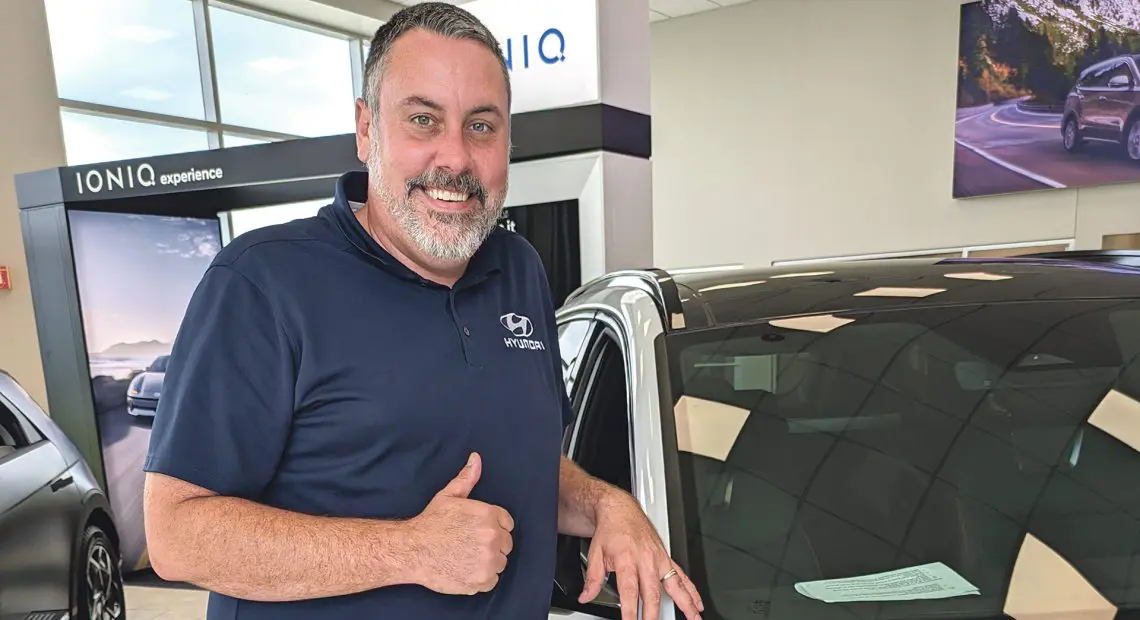Shifting into a Higher Gear

Brian Houser, general manager of Balise Hyundai, says factors ranging from inventory to incentives are trending in an optimistic direction.
It can be tough to find a parking spot at Marcotte Ford, but Sue Keller says that’s a good problem to have.
Over the past few years, “we got creative, like skipping every space, trying to look like we had more inventory,” she told BusinessWest. “But now, it’s great to see a full fleet out there. And I think it’s just brought up the morale for the whole team here, which is nice.
“When the truck pulls up now, the sales team are like little kids in the window — they want to see what’s rolling off, what’s coming in, and then they sit down and look at who’s put requests in,” added Keller, the dealership’s marketing director. “I feel like the sales team is more upbeat with more inventory. It’s a better vibe out there. They’re ready to sell, and they have it to sell now.”
Inventory, in fact, seems to be the biggest positive development in auto sales across the region, following a pandemic-related shortage that, as Keller noted, forced dealerships to get creative on half-empty lots.
“Inventory is back to being healthy,” said Mike Marcotte, president of the Holyoke-based store. “So when a customer comes in here, compared to six months ago, they have more options, more colors. And then, if they want to factory-order something, Ford has streamlined it, and it’s coming in faster, which is great. Before, the lead time was four to six months; now, it’s a lot faster with the production cycle.
“I feel like the sales team is more upbeat with more inventory. It’s a better vibe out there. They’re ready to sell, and they have it to sell now.”
“So customers can choose exactly what they want instead of settling on something,” he added. “And they can see it. Instead of looking online for a picture, they can see it in person, and drive away that day if they want.”
Brian Houser, general manager of Balise Hyundai in Springfield, has seen a similar inventory rebound.

Mike Marcotte says having plenty of inventory on the lot is important not just to give buyers options, but because they want to see and touch what they’ll be buying.
“Most brands have been able to fill their lots back so customers have more varieties and choices,” he said, adding that, while used-car access continues to fluctuate following a recent drought, new-car selection is strong. “Consumers have been coming out. They have an opportunity to test drive more makes and models. Before, they’d show up on a parking lot, and there wouldn’t be any inventory for them to even test drive. Now, they have more opportunity to see exactly what they’re looking for.”
Carla Cosenzi, president of TommyCar Auto Group, agreed.
“Inventory levels have improved significantly,” she said. “Our used-vehicle inventory is robust, thanks to our trade-in programs and strategic sourcing, ensuring a wide range of options for our customers. Additionally, we have over 500 new vehicles across our five brands, providing an extensive selection for buyers.”
Business across the TommyCar dealerships has been strong in 2024, she added, with consistent demand for both new and pre-owned vehicles.
“We use live market pricing to always ensure we are priced competitively in the market, and these are some of the best incentives we have seen from the manufacturers,” she added, noting a range of incentives to attract buyers, including low-interest financing, lease specials, cash rebates, and loyalty programs, in addition to TommyCar-specific perks like 15% back on service spending (which can be used toward a future car purchase), gift certificates when customers hit certain points in their rewards account, and complimentary service loaners.
“We had a great start to July, and we’re actually looking for a bigger second half of the year than the first half of the year.”
With more inventory, Ford has enhanced its rebates as well, Marcotte noted, like 2.99% financing on a Ford F-150 that kicked off on July 15 and will continue through the summer.
“They’re trying to stay more consistent over a longer period. So it’s not 15 days — it will last the whole month or the whole summer. So we can plan inventory accordingly and reach out to customers that may be in the market or were in the market, and tell them this special is out right now.”
As a result, “we had a great start to July, and we’re actually looking for a bigger second half of the year than the first half of the year,” he added. “Especially as a big commercial truck dealer, with Super Duties and Transits, we’re also ramping up for that, for the end of the year.”
The luxury vehicle market is robust as well, according to Peter Wirth, who co-owns Mercedes-Benz of Springfield with his wife, Michelle Wirth.
“It’s a good environment for us. Inventory levels are back to pre-pandemic levels,” he said, adding that SUV sales are especially strong, citing the brand’s GLC and GLE models.

Michelle and Peter Wirth say customers are often surprised that some luxury cars at Mercedes-Benz of Springfield aren’t far from the price points at other dealerships.
“We have always had a powertrain for any liking, whether you want a gas-powered vehicle, an all-electric vehicle, or a plug-in hybrid,” Michelle added. “People may not realize they can afford a Mercedes — they may not realize that, when they’re driving other cars, their price point is similar to ours.”
EV Landscape in Flux
One trend that seems to have slowed nationally is the realm of electric vehicles. Locally, however, dealers are still embracing their potential.
“We’ve actually been doing steady with it. Our whole team has learned it, so it’s not just one or two specialists; they’re all fluent with it,” Marcotte said, adding that his dealership has invested in high-speed charging stations as well, so customers can familiarize themselves with them. Meanwhile, state and federal incentives and rebates continue to be attractive, he added.
While some customers remain leery about charging infrastructure and how that affects range, he noted that hybrids continue to sell well, serving as a mileage-efficient middle ground between all-gas vehicles and electrics.
“We want people to feel comfortable. We don’t want them to make a purchase and not feel comfortable. Obviously, with all the different chargers in the area, once you start looking for them, you start seeing more and more. And then you can do the at-home charger.”
That said, EVs — Ford offers the Mach-E, the F-150 Lightning, and the E-Transit — represented 8% of Marcotte’s business in June. “And then we’ll have new products in 2026 and 2027. So that’s been going well. We’re glad we can offer all those ranges — EVs, gas, hybrid, and commercial diesels.”
Cosenzi said she’s seeing increased incentives for electric vehicles and hybrid models, reflecting the industry’s push towards sustainable mobility, and TommyCar has prepared for that shift by expanding its EV inventory and investing in charging stations. “These incentives make it an excellent time for customers to explore both traditional and alternative fuel vehicles.”
“We have charging stations on our campus. But until your condo complexes have them set up, your Starbucks, your Dunkin’ Donuts, places that people can spend 15 to 20 minutes charging their vehicle … until you start to see that, it’s going to be tough for the average consumer.”
Houser said “range anxiety” is still a factor, even though range on EVs has increased substantially and charging stations continue to spring up.
“And there are still plenty of incentives from the state and federal government that are incentivizing these customers to buy EVs,” he noted. “But the infrastructure is the most important thing. We have charging stations on our campus. But until your condo complexes have them set up, your Starbucks, your Dunkin’ Donuts, places that people can spend 15 to 20 minutes charging their vehicle … until you start to see that, it’s going to be tough for the average consumer.”
For now, he agrees with Marcotte that many consumers who desire the mileage of an electric vehicle are more comforable with hybrids.
“The benefit of the hybrid is you don’t have to worry about charging it; the battery itself does it,” Houser noted. “When you’re doing your braking, your regenerative braking system powers everything so there’s no range anxiety of what could go wrong if you can’t get it charged — you’re just putting gas in and relying on the mechanics of the vehicle.”
Peter Wirth said EV adoption has been lower than anticipated, while hybrids remain very much in demand, and Mercedes-Benz of Springfield is stocking accordingly. But he agrees with others that, once people become more comfortable with charge-station availability, both locally and nationally, the future is still bright for all-electric cars and trucks.
“Nobody has a crystal ball,” Michelle added. “But it only stands to reason that, as the charging infrastructure grows in the area, so will the adoption.”
Drive Time
That said, business is normalizing, for both Mercedes as a whole and the Wirths’ Chicopee-based dealership.
“It’s been only seven years, so we’re still getting known in this market,” Peter said. “We’re still selling new cars, factory orders are back to pre-pandemic lead times, and, for customers, the deals are back. Leasing and financing deals are important for us so we can stay competitive.”
TommyCar continues to grow, Conzenzi said, even at a time when all sectors are struggling with talent retention. “We focus on creating a positive work environment, offering competitive compensation, and providing continuous training and development opportunities. Our culture emphasizes teamwork, innovation, and customer-centric service, which helps us attract and retain dedicated professionals.”
The main downside for consumers right now, Houser said, is felt by those who bought at a high point in the market and may be upside down on their loan compared to what their always-depreciating vehicle is worth.
“A lot of people avoid that by leasing a vehicle. Or, if you’ve got to hunker down and keep your vehicle, try to put more money into principal because so many consumers put no money down, rolling in all the taxes and registration fees, and then, at that point, you’re financing the full amount at a high retail price that didn’t have incentives or programs before.”
With the average monthly car payment in the U.S. around $700, Houser added, he’s seeing more consumers finance for a longer period — six or seven years instead of five. “But over the long haul, they have to hopefully realize how much money is going to the bank when you’re financing a car for a longer period of time.”
That’s why the return of rate and rebate incentives are so welcome, he noted, and why new cars are starting to look better than used ones, which rely on local bank financing at higher rates than new cars.
“And the rebates are back in play,” he added. “I’m sure you’ve heard the TV ads. When COVID was going on, you didn’t hear the radio, TV, or billboard ads for two, three, four, five thousand dollars off. Now that inventory is back, we have to get these vehicles into people’s driveways, and the manufacturers give us incentives in order to help us out with that.”






